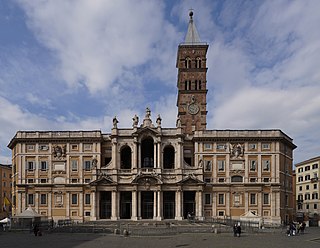
The Basilica of Saint Mary Major, or church of Santa Maria Maggiore, is a Major papal basilica as well as one of the Seven Pilgrim Churches of Rome and the largest Catholic Marian church in Rome, Italy.

The Basilica of Santa Maria in Trastevere ; English: Our Lady in Trastevere) is a titular minor basilica in the Trastevere district of Rome, and one of the oldest churches of Rome. The basic floor plan and wall structure of the church date back to the 340s, and much of the structure to 1140–43. The first sanctuary was built in 221 and 227 by Pope Callixtus I and later completed by Pope Julius I. The church has large areas of important mosaics from the late 13th century by Pietro Cavallini.

There are more than 930 churches in Rome, which makes it the city with the largest number of churches in the world. Almost all of these are Catholic.

San Martino ai Monti, officially known as Santi Silvestro e Martino ai Monti, is a minor basilica in Rome, Italy, in the Rione Monti neighbourhood. It is located near the edge of the Parco del Colle Oppio, near the corner of Via Equizia and Viale del Monte Oppio, about five to six blocks south of Santa Maria Maggiore.

Giuseppe Valadier was an Italian architect and designer, urban planner and archaeologist and a chief exponent of Neoclassicism in Italy.
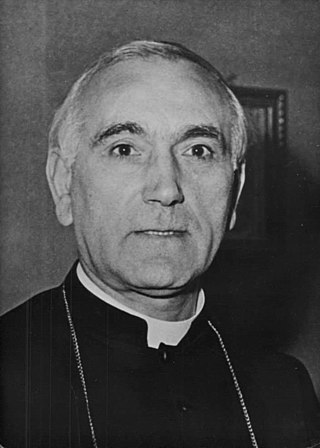
Carlo Confalonieri was an Italian cardinal of the Roman Catholic Church. He served as prefect of the Congregation for Bishops from 1967 to 1973, and dean of the College of Cardinals from 1977 until his death. Confalonieri was elevated to the cardinalate in 1958.

Eugène-Gabriel-Gervais-Laurent Tisserant was a French prelate and cardinal of the Catholic Church. Elevated to the cardinalate in 1936, Tisserant was a prominent and long-time member of the Roman Curia.

Virgilio Noè was an Italian Roman Catholic prelate and cardinal. He was elevated to the cardinalate in 1991.

The Basilica of San Camillo de Lellis is a church on Via Sallustiana, Rome, Italy. It is dedicated to Saint Camillus de Lellis (1550–1614).

Santa Sofia a Via Boccea is a church in Rome, Italy. It is dedicated to Holy Wisdom, one of the seven gifts of the Holy Spirit. It served as the mother church of the Ukrainian Greek Catholic Church while St. George's Cathedral in Lviv was controlled by the Russian Orthodox Church.

Benedetto Aloisi Masella was an Italian cardinal of the Roman Catholic Church who served as prefect of the Discipline of the Sacraments from 1954 to 1968, and as chamberlain of the Roman Church from 1958 until his death. Aloisi Masella was elevated to the cardinalate in 1946 by Pope Pius XII, whom he designated to canonically crown Our Lady of Fatima.

Clemente Micara was an Italian prelate of the Roman Catholic Church. He worked in the diplomatic service of the Holy See from 1909 to 1950 and was Vicar General of Rome from 1951 until his death.
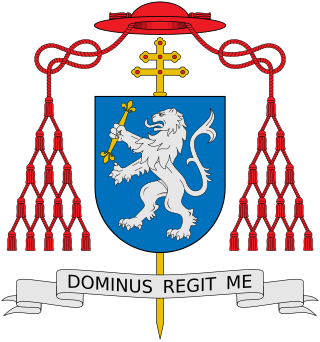
Pietro Ciriaci was an Italian Cardinal of the Catholic Church who served as prefect of the Sacred Congregation of the Council in the Roman Curia from 1954 until his death, and was elevated to the cardinalate in 1953 by Pope Pius XII.

The Basilica of Saints John and Paul on the Caelian Hill is an ancient basilica church in Rome, located on the Caelian Hill. It was originally built in 398.
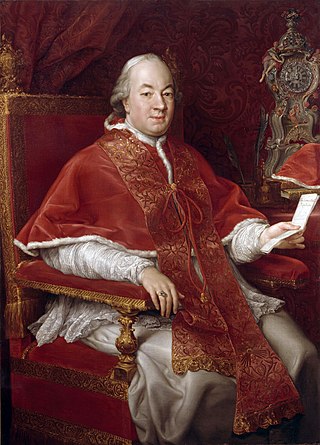
The 1774–75 papal conclave, was convoked after the death of Pope Clement XIV and ended with the election of Cardinal Giovanni Angelo Braschi, who took the name of Pius VI.

Sérgio da Rocha is a Brazilian prelate of the Catholic Church who has been a cardinal since 2016 and the Archbishop of São Salvador da Bahia since 11 March 2020. He has been a bishop since 2001, first as auxiliary bishop of Fortaleza from 2001 to 2007, coadjutor and then archbishop of Teresina from 2007 to 2011, and archbishop of Brasília from 2011 to 2020. He is a member of the Council of Cardinals.

Giovanni Ottavio Manciforte Sperelli (1730–1781) was an Italian Roman Catholic bishop and cardinal.
Gianantonio Capizucchi was an Italian Roman Catholic cardinal and bishop.
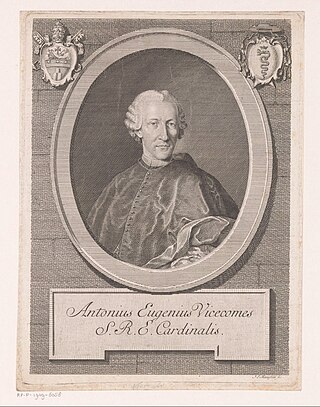
Antonio Eugenio Visconti was an Italian cardinal and archbishop of the Catholic Church.

San Giuseppe al Trionfale is a 20th-century minor basilica and titular church in Rome, located immediately north of the Vatican, dedicated to Saint Joseph.





















